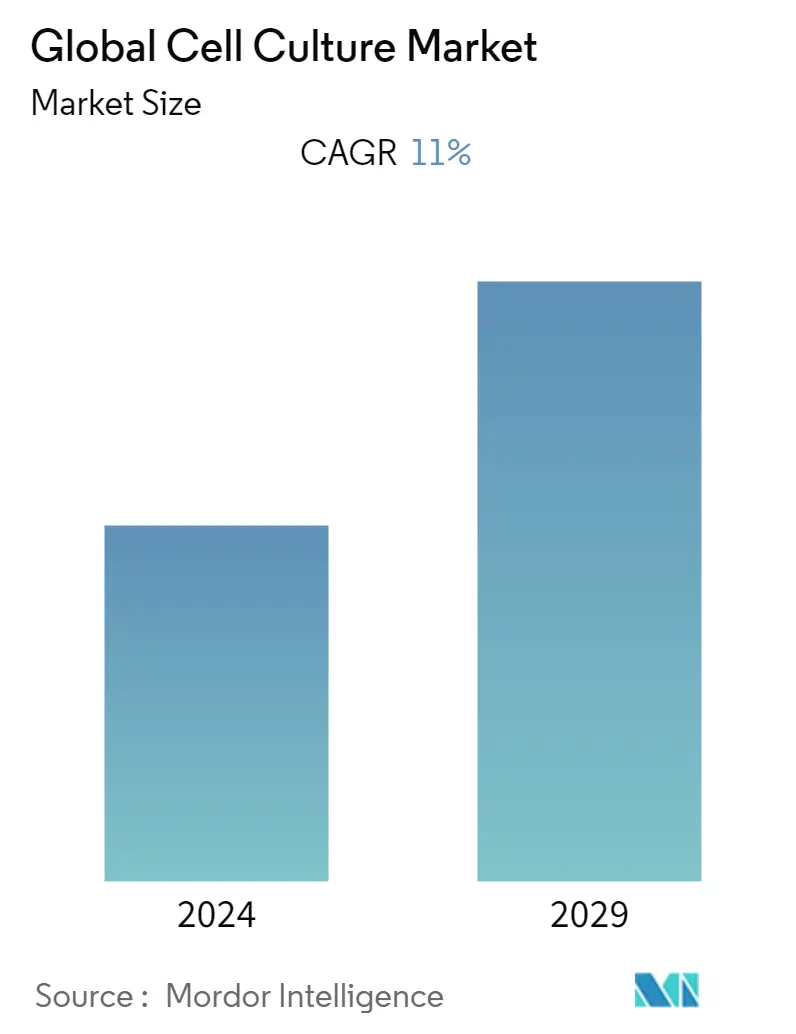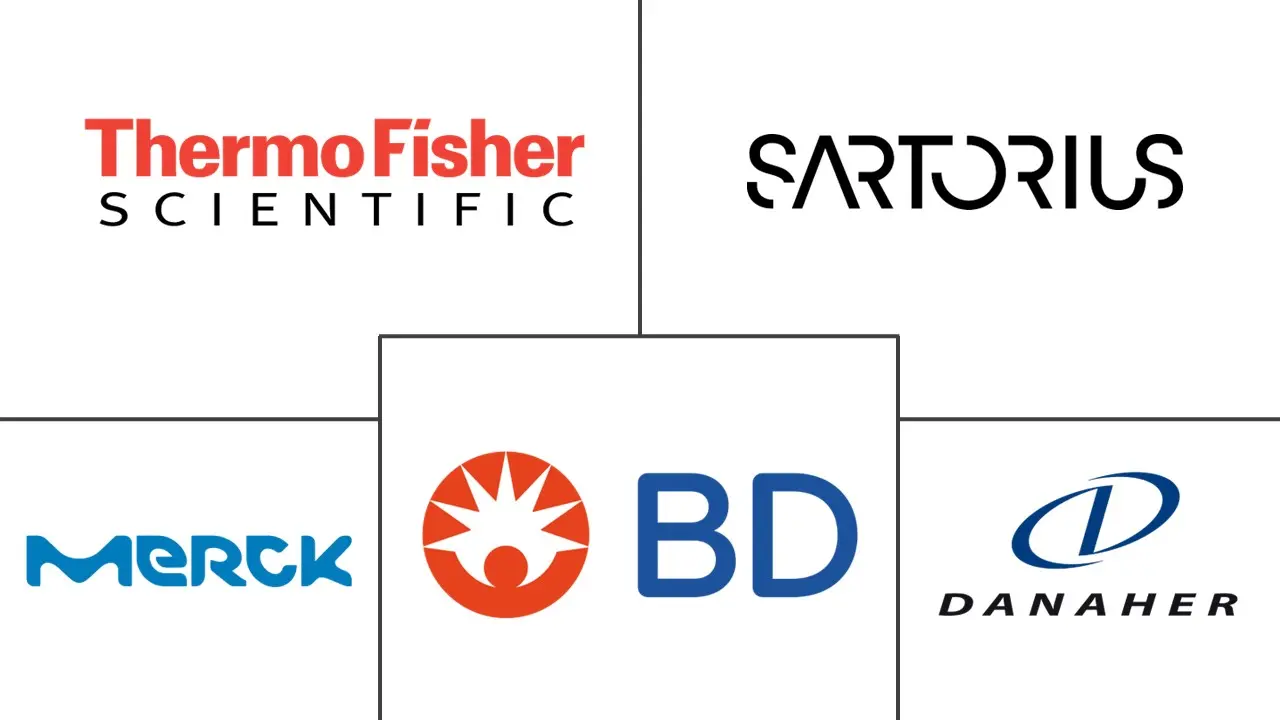Market Size of Global Cell Culture Industry

| Study Period | 2019 - 2029 |
| Base Year For Estimation | 2023 |
| Forecast Data Period | 2024 - 2029 |
| CAGR | 11.00 % |
| Fastest Growing Market | Asia Pacific |
| Largest Market | North America |
Major Players
*Disclaimer: Major Players sorted in no particular order |
Cell Culture Market Analysis
The cell culture market is expected to witness a CAGR of 11.0% over the forecast period (2022-2027).
With the onset of COVID-19, many biotech and pharmaceutical firms, government organizations in various countries, and research institutes started to focus on the development of effective vaccines and new therapeutics to overcome the situation. Cell culture may serve as a potential platform for the development of novel vaccines for the treatment of COVID-19. Additionally, initiatives taken by the market players in such directions also led to a significant impact on the market's growth. For instance, in January 2021, Captivate Bio launched its portfolio of cell culture tools to assist in the fight against COVID-19 and other emerging diseases in the United States. Thus, COVID-19 had a pronounced impact on the growth of the market.
The major factors such as the growing demand for personalized medicine coupled with the rise in the demand for vaccines, biopharmaceuticals, and artificial organs coupled with the advancement in technology and the launch of products and consumables are driving the growth of the market over the forecast period.
According to GLOBOCAN Statistics, there were an estimated 19.3 million new cases of cancer around the world in the year 2020, and it is projected to reach 30.2 million by 2040. Such an increasing burden of cancer creates the need for precision medicine, so the demand for cell culture is expected to increase over the coming years as cell culture plays a vital role in the development of personalized medicine. Additionally, increasing research and development in pharmaceuticals and biopharmaceuticals also contributes largely to the growth of the market. For instance, according to the European Federation of Pharmaceutical Industries and Associations, 2022 report, the pharmaceutical industry in Europe incurred expenses of EUR 39,656 million for its research and development, and for 2022, this expense is expected to be EUR 41,500 million. Such an increasing focus on research and development creates the need for cell cultures for testing the effectiveness of the drug and thus drives the growth of the market.
The launch of products is also expected to drive the growth of the market. For instance, in March 2021, Thermo Fisher Scientific launched its new Gibco Human Plasma-like Medium (HPLM). It is one of the first types of cell culture medium that mimics the metabolic profile of human plasma and is designed to provide researchers with a realistic view of cell growth within the human body.
Additionally, the launch of technologically advanced and innovative products also propels the growth of the market. For instance, in February 2022, Nucleus Biologics launched Krakatoa. It is an innovative, one of the first to market media makers that helps researchers to manufacture cell culture media at the point of use.
Thus, owing to the abovementioned factors, the cell culture market is expected to show considerable growth over the forecast period. However, the high cost associated with cell-based research and the lack of infrastructure for cell-based research in emerging economies may impede the growth of the market.
Cell Culture Industry Segmentation
As per the scope of the report, cell culture is the process of growing the cell under certain controlled conditions outside its natural environment. Once the cells of interest have been isolated from living tissue, they can subsequently be maintained under carefully controlled conditions. The Cell Culture Market is Segmented by Products and Consumables (Products (Biosafety Equipment, Centrifuges, Cryostorage Equipment, Culture Systems/Bioreactors, Incubators, Pipetting Instruments and Others) and Consumables (Media, Sera, and Reagents)), Application (Biopharmaceuticals, Drug Development, Gene Therapy, Tissue Culture and Engineering, Vaccine Production, and Others), and Geography (North America, Europe, Asia-Pacific, Middle East and Africa, and South America). The market report also covers the estimated market sizes and trends for 17 different countries across major regions, globally. The report offers the value (in USD million) for the above segments.
| By Product and Consumables | |||||||||
| |||||||||
|
| By Application | |
| Biopharmaceuticals | |
| Drug Development | |
| Gene Therapy | |
| Tissue Culture and Engineering | |
| Vaccine Production | |
| Other Applications |
| Geography | ||||||||
| ||||||||
| ||||||||
| ||||||||
| ||||||||
|
Global Cell Culture Market Size Summary
The cell culture market is poised for significant expansion, driven by the increasing demand for personalized medicine, vaccines, biopharmaceuticals, and artificial organs. The COVID-19 pandemic has notably accelerated market growth, as it prompted biotech and pharmaceutical companies, along with research institutions, to leverage cell culture technologies for vaccine development. This surge in demand is further supported by technological advancements and the introduction of innovative products, such as Thermo Fisher Scientific's Gibco Human Plasma-like Medium and Nucleus Biologics' Krakatoa media makers. These developments underscore the critical role of cell culture in medical research and drug discovery, particularly in the context of precision medicine and cancer treatment. However, challenges such as high research costs and inadequate infrastructure in emerging economies may pose obstacles to market growth.
North America currently leads the cell culture market, benefiting from a robust demand for personalized medicine and the presence of key industry players. The region's growth is further bolstered by product launches and advancements in cell culture technologies, which enhance the development of monoclonal antibodies, vaccines, and therapeutic cells. The market's competitive landscape is characterized by the dominance of major players like Thermo Fisher Scientific, Danaher Corporation, and Sartorius AG, who continually innovate and improve cell culture platforms. Government support and collaborative initiatives, such as Merck's partnership with GI Innovation, also contribute to the market's expansion. Despite the competitive nature of the market, these factors collectively drive the cell culture industry's growth trajectory over the forecast period.
Global Cell Culture Market Size - Table of Contents
-
1. MARKET DYNAMICS
-
1.1 Market Overview
-
1.2 Market Drivers
-
1.2.1 Rise in the Demand for Vaccines, Biopharmaceuticals and Artificial Organs
-
1.2.2 Growing Focus on Personalized Medicine
-
-
1.3 Market Restraints
-
1.3.1 High Cost Associated with Cell Based Research
-
1.3.2 Lack of Infrastructure for Cell-based Research in Emerging Economies
-
-
1.4 Industry Attractiveness - Porter's Five Forces Analysis
-
1.4.1 Bargaining Power of Buyers/Consumers
-
1.4.2 Bargaining Power of Suppliers
-
1.4.3 Threat of New Entrants
-
1.4.4 Threat of Substitute Products
-
1.4.5 Intensity of Competitive Rivalry
-
-
-
2. MARKET SEGMENTATION (Market Size by Value - USD million)
-
2.1 By Product and Consumables
-
2.1.1 Product
-
2.1.1.1 Biosafety Equipment
-
2.1.1.2 Centrifuges
-
2.1.1.3 Cryostorage Equipment
-
2.1.1.4 Culture Systems/Bioreactors
-
2.1.1.5 Incubators
-
2.1.1.6 Pipetting Instruments
-
2.1.1.7 Others
-
-
2.1.2 Consumables
-
2.1.2.1 Media
-
2.1.2.2 Sera
-
2.1.2.3 Reagents
-
-
-
2.2 By Application
-
2.2.1 Biopharmaceuticals
-
2.2.2 Drug Development
-
2.2.3 Gene Therapy
-
2.2.4 Tissue Culture and Engineering
-
2.2.5 Vaccine Production
-
2.2.6 Other Applications
-
-
2.3 Geography
-
2.3.1 North America
-
2.3.1.1 United States
-
2.3.1.2 Canada
-
2.3.1.3 Mexico
-
-
2.3.2 Europe
-
2.3.2.1 Germany
-
2.3.2.2 United Kingdom
-
2.3.2.3 France
-
2.3.2.4 Italy
-
2.3.2.5 Spain
-
2.3.2.6 Rest of Europe
-
-
2.3.3 Asia-Pacific
-
2.3.3.1 China
-
2.3.3.2 Japan
-
2.3.3.3 India
-
2.3.3.4 Australia
-
2.3.3.5 South Korea
-
2.3.3.6 Rest of Asia-Pacific
-
-
2.3.4 Middle East and Africa
-
2.3.4.1 GCC
-
2.3.4.2 South Africa
-
2.3.4.3 Rest of Middle East and Africa
-
-
2.3.5 South America
-
2.3.5.1 Brazil
-
2.3.5.2 Argentina
-
2.3.5.3 Rest of South America
-
-
-
Global Cell Culture Market Size FAQs
What is the current Global Cell Culture Market size?
The Global Cell Culture Market is projected to register a CAGR of 11% during the forecast period (2024-2029)
Who are the key players in Global Cell Culture Market?
Thermo Fisher Scientific, Danaher Corporation, Sartorius AG, Merck KGaA and Becton, Dickson and Company are the major companies operating in the Global Cell Culture Market.

